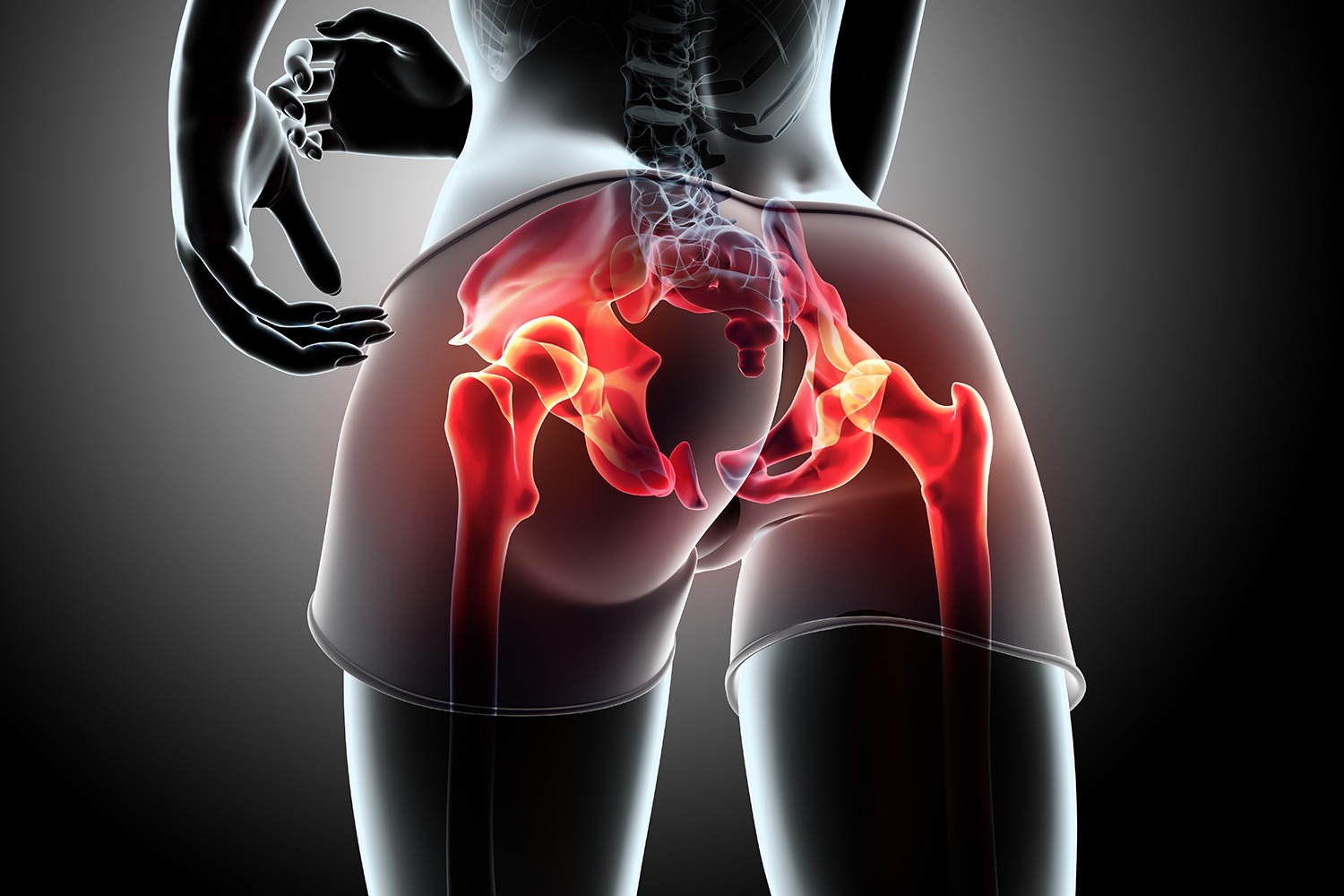Hip Replacement
A total hip replacement is a surgical procedure whereby the diseased cartilage and bone of the hip joint is surgically replaced to relieve the patient of his discomfort. If the hip has been damaged by arthritis, a fracture, or because of heavy impact; performing regular activities may become painful and difficult. One will find stiffness in the hip, and discomfort while walking, or bending and perhaps even while resting.

Types of Hip Replacement
1. Uncemented Total Hip Replacement: Both the socket and the stem components are fitted into the bone without using acrylic bone cement. This is a precision operation and the bone grows into the surface of the components holding them securely. This type of replacement is advised for younger patients.
2. Cemented Total Hip Replacement: Both the socket and the stem are fixed into the bone using acrylic bone cement. This is advised for elderly patients above the age of 65 years.
3. Hip Surface Replacement: Instead of sacrificing the worn-out head of the femur (ball), only the surface is shaved off and a new surface is fitted onto the socket and the head of the femur. This is a bone preserving operation that allows patients faster recovery and patients can have a full range of movements allowing them to squat and sit cross-legged.

Why Hip Replacement Surgery?
The orthopaedic surgeon may advise hip replacement surgery to offer a long-term solution when
- Hip pain that limits everyday activities and impairs overall quality of life, such as walking or bending
- Hip pain that continues while resting, either day or night
- Stiffness in a hip that limits the ability to move or lift the leg
- Inadequate pain relief from anti-inflammatory drugs, physical therapy, or walking supports
Total hip replacements are performed most commonly because of progressively worsening of severe arthritis in the hip joint. The most common type of arthritis leading to total hip replacement is osteoarthritis of the hip joint. The most common cause of chronic hip pain and disability is arthritis. Osteoarthritis, rheumatoid arthritis, and traumatic arthritis are the most common forms of this disease. Avascular necrosis, Childhood hip disease are the other possible reasons for Hip Replacement.
A hip replacement can
- Relieve pain
- Help your hip joint work better
- Improve walking and other movements
It is a decision that is made after proper investigations and clinical examinations, previous medical history with an understanding of the potential risks and benefits. A detailed understanding of both the procedure and expected results should be discussed at length with the orthopaedic surgeon.

What to expect from Hip replacement
An important factor in deciding whether to have total hip replacement operation is understanding what the operation can and can’t do. More than 90 percent of individuals who undergo hip replacement surgery experience a dramatic reduction of hip pain and a significant improvement in their ability to perform the common activities of daily living. However, hip replacement surgery will not enable you to do more than you could before your hip problem developed. For example, if you could not run for 5 kilometers before your hip problem started, do not expect to do so after your surgery. Following surgery, you will be advised to avoid certain activities for the rest of your life including jogging and high-impact sports.
Even with normal use and activities, an artificial joint (prosthesis) develops minimal wear over time. If you decide to participate in high-impact activities or are over-weight, this wear may accelerate and cause the prosthesis to loosen and become painful. With appropriate activity modification, hip replacement can last several years.
Hip replacement surgical procedure
You will most likely be admitted to the hospital on the day before your surgery. After admission, you will be evaluated by a member of the anesthesia team. The most common types of anesthesia for hip replacement surgery are general anesthesia (which puts you to sleep throughout the procedure) or spinal anesthesia (which allows you to be awake but anesthetizes your body from the waist down). The anesthesia team will discuss these choices with you and help you decide which type of anesthesia is best for you.

Surgical Procedure
In Hip Replacement Surgery, the surgeon removes the damaged sections of your hip joint and replaces them with parts usually constructed of metal, ceramic and very hard plastic. This artificial joint or prosthesis helps reduce pain and improve function. The joint replacement surgeon will make a cut along the side of the hip and move the muscles connected to the top of the thighbone (femur) to expose the hip joint. Next, the ball portion of the joint is removed by cutting the thighbone with surgical devices.
An artificial joint is then attached to the thighbone using either bone cement or a special material that allows the remaining bone to attach to the new joint. The doctor then prepares the surface of the hipbone, removing any damaged cartilage and attaches the prosthetic socket part to the hip bone. The new ball part of the thighbone is then inserted into the socket part of the hip. A drain may be put in to help drain any fluid. The doctor then reattaches the muscles and closes the incision.
The surgery itself takes about 90 minutes. However, preparation and anesthesia before surgery and recovery after surgery will keep you in theatre for a total of about three hours. Your orthopedic surgeon will remove the damaged cartilage and bone, then position new metal and plastic joint surfaces to restore the alignment and function of your hip.
The prosthetic components could either be ‘press fit’ into the bone or they may be cemented into place. Based on a number of factors, such as the quality and strength of your bone, the orthopaedic surgeon will decide to press-fit or to cement the components or use a combination of both.
Many different types of designs and materials are currently used in artificial hip joints. All of them consist of two basic components: the ball component (made of a highly polished strong metal) and the socket component (a durable plastic cup which may have an outer metal shell).
Acrylic surgical bone cement may be used to fill the gap between the prosthesis and remaining natural bone to secure the artificial joint.
A uncemented prosthesis has also been developed which is used most often in younger, more active patients. The prosthesis may be coated with textured metal or a special bone-like substance which allows the bone to grow into the prosthesis.
A combination of a cemented ball and a uncemented socket may be used.
Your orthopedic surgeon will choose the type of prosthesis that best meets your needs. After surgery, you will be moved to the recovery room where you will remain for one to two hours while the recovery from anesthesia is monitored. After you awaken fully, you will be taken to your hospital room.
Post Surgery Care
Most often than not, the complication rate following hip replacement surgery is low. With the advancement in Technology, the post-operative complications are lower and recovery of the patient is faster. After the operation, you’ll need a walking aid, such as a walker for support initially. You may also be enrolled in an exercise program that’s designed to help you regain and then improve the use of your new hip joint. But with proper exercise and a nutritional diet rich in protein, Calcium and Vit D the recovery time is shorter and patient satisfaction is extremely high.
It is imperative that your orthopaedic surgeon is well-equipped and highly skilled to conduct these joint replacement surgeries with proper infection control. Improper treatments can lead to dislocations, change in leg length, clots, etc, among others.
Possible complication after surgery
The complication rate following hip replacement surgery is low. Serious complications, such as joint infection, occur in less than 2 percent of patients. Major medical complications, such as heart attack or stroke, occur even less frequently. However, chronic illnesses may increase the potential for complications. Although uncommon, when these complications occur they can prolong or limit your full recovery. Blood clots in the leg veins or pelvis are the most common complication of hip replacement surgery. Your orthopedic surgeon may prescribe one or more measures to prevent blood clots from forming in your leg veins, such as special support hose, inflatable leg coverings, and blood thinners.
Your Recovery at Home :
The success of your surgery will depend in large measure on how well you follow your orthopedic surgeon’s instructions regarding home care during the first few weeks after surgery.
Wound Care :
You will have stitches or staples running along your wound or a suture beneath your skin. The stitches or staples will be removed about two weeks after surgery. Avoid getting the wound wet until it has thoroughly sealed and dried. A bandage may be placed over the wound to prevent irritation from clothing or support stockings.
Diet :
Some loss of appetite is common for several weeks after surgery. A balanced diet, often with an iron supplement, is important to promote proper tissue healing and restore muscle strength. Be sure to drink plenty of fluids.
Activity :
Exercise is a critical component of home care, particularly during the first few weeks after surgery. You should be able to resume most normal light activities of daily living within three to six weeks following surgery. Some discomfort with activity, and at night, is common for several weeks.
Your activity program should include :
- A graduated walking program initially in your home and later outside.
- walking program to slowly increase your mobility and endurance.
- Resuming other normal household activities.
- Resuming sitting, standing, walking up and downstairs.
- Specific exercises several times a day to restore movement.
- Specific exercises several times a day to strengthen your leg muscles.
- You may wish to have a physiotherapist to help you at home.
Avoiding Problems After Surgery
Blood Clot Prevention:
Follow your orthopaedic surgeon’s instructions carefully to minimize the potential risk of blood clots in your leg veins, which can occur during first several weeks of your recovery.
Warning signs of possible blood clots include pain in your calf and leg unrelated to your incision, tenderness or redness of your calf, swelling of your thigh, calf, ankle or foot. Warning signs that a blood clot has traveled to your lungs include shortness of breath, chest pain, particularly with breathing. Notify your doctor immediately if you develop any of these signs.
Preventing Infection :
The most common causes of late infection following hip replacement surgery are from bacteria that enter the bloodstream during dental procedures, urinary tract infections, or skin infections. These bacteria can lodge around your prosthesis.
Persistent fever (higher than 100 degrees orally), shaking chills, increasing redness, tenderness, or swelling of the hip wound, drainage from the hip wound, increasing hip pain with both activity and rest. Notify your doctor immediately if you develop any of these signs.
Avoiding Falls :
A fall during the first few weeks after surgery can damage your new hip and may result in a need for more surgery. Stairs are a particular hazard until your hip is strong and mobile. You should use a cane, crutches, a walker, or handrails, or have someone help you until you improve your balance, flexibility and strength.
Your surgeon and physiotherapist will help you decide what assistive aides will be required following surgery, and when those aides can safely be discontinued.

